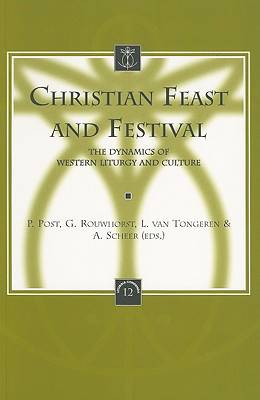
Je cadeautjes zeker op tijd in huis hebben voor de feestdagen? Kom langs in onze winkels en vind het perfecte geschenk!
- Afhalen na 1 uur in een winkel met voorraad
- Gratis thuislevering in België vanaf € 30
- Ruim aanbod met 7 miljoen producten
Je cadeautjes zeker op tijd in huis hebben voor de feestdagen? Kom langs in onze winkels en vind het perfecte geschenk!
- Afhalen na 1 uur in een winkel met voorraad
- Gratis thuislevering in België vanaf € 30
- Ruim aanbod met 7 miljoen producten
Zoeken
€ 161,45
+ 322 punten
Omschrijving
This collection on Christian feast culture is closely connected with the first Dutch national research program, Liturgical Movements and Feast Culture, which was conceived and initiated in 1995, and coordinated by the Interuniversity Liturgical Institute, headquartered in Tilburg. The collection marks the conclusion of the program, and through a report of work in progress is intended to present a sort of sampler of Dutch liturgical studies for an international forum. Against the broader background of modern multidisciplinary liturgical studies and the theme of liturgical movements, the dynamic of cultus and culture, Christian feast culture in the year and in life forms the central theme of the collection. A number of choices have had to be made as this developed. For example, the collection almost exclusively focuses on Western Christian rituality, in which, within that Western perspective, broader ritual contexts are brought into the discussion. The collection is divided into four parts. In addition to an introduction (part I) to situate the topic, part II contains a series of systematic, theoretical explorations, which present diverse but also converging disciplinary approaches, generally illustrating them as well. Part III comprises historical explorations. Part IV comprises studies in contemporary liturgical practice, including the liturgia condenda. Each of the parts II-IV has an introduction in which an effort is made to offer some lines of synthesis and evaluation.
Specificaties
Betrokkenen
- Auteur(s):
- Uitgeverij:
Inhoud
- Aantal bladzijden:
- 808
- Taal:
- Engels
- Reeks:
- Reeksnummer:
- nr. 12
Eigenschappen
- Productcode (EAN):
- 9789042910553
- Verschijningsdatum:
- 31/12/2001
- Uitvoering:
- Paperback
- Formaat:
- Trade paperback (VS)
- Afmetingen:
- 152 mm x 229 mm
- Gewicht:
- 1020 g

Alleen bij Standaard Boekhandel
+ 322 punten op je klantenkaart van Standaard Boekhandel
Beoordelingen
We publiceren alleen reviews die voldoen aan de voorwaarden voor reviews. Bekijk onze voorwaarden voor reviews.









